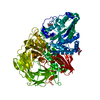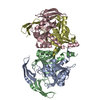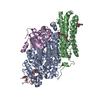+ Open data
Open data
- Basic information
Basic information
| Entry | Database: PDB / ID: 6coy | ||||||
|---|---|---|---|---|---|---|---|
| Title | Human CLC-1 chloride ion channel, transmembrane domain | ||||||
 Components Components | Chloride channel protein 1 | ||||||
 Keywords Keywords | TRANSPORT PROTEIN / chloride / channel / CLC | ||||||
| Function / homology |  Function and homology information Function and homology informationvoltage-gated chloride channel activity / neuronal action potential propagation / chloride transport / chloride channel complex / T-tubule / chloride transmembrane transport / muscle contraction / Stimuli-sensing channels / protein homodimerization activity / plasma membrane Similarity search - Function | ||||||
| Biological species |  Homo sapiens (human) Homo sapiens (human) | ||||||
| Method | ELECTRON MICROSCOPY / single particle reconstruction / cryo EM / Resolution: 3.36 Å | ||||||
 Authors Authors | Park, E. / MacKinnon, R. | ||||||
| Funding support |  United States, 1items United States, 1items
| ||||||
 Citation Citation |  Journal: Elife / Year: 2018 Journal: Elife / Year: 2018Title: Structure of the CLC-1 chloride channel from . Authors: Eunyong Park / Roderick MacKinnon /  Abstract: CLC channels mediate passive Cl conduction, while CLC transporters mediate active Cl transport coupled to H transport in the opposite direction. The distinction between CLC-0/1/2 channels and CLC ...CLC channels mediate passive Cl conduction, while CLC transporters mediate active Cl transport coupled to H transport in the opposite direction. The distinction between CLC-0/1/2 channels and CLC transporters seems undetectable by amino acid sequence. To understand why they are different functionally we determined the structure of the human CLC-1 channel. Its 'glutamate gate' residue, known to mediate proton transfer in CLC transporters, adopts a location in the structure that appears to preclude it from its transport function. Furthermore, smaller side chains produce a wider pore near the intracellular surface, potentially reducing a kinetic barrier for Cl conduction. When the corresponding residues are mutated in a transporter, it is converted to a channel. Finally, Cl at key sites in the pore appear to interact with reduced affinity compared to transporters. Thus, subtle differences in glutamate gate conformation, internal pore diameter and Cl affinity distinguish CLC channels and transporters. | ||||||
| History |
|
- Structure visualization
Structure visualization
| Movie |
 Movie viewer Movie viewer |
|---|---|
| Structure viewer | Molecule:  Molmil Molmil Jmol/JSmol Jmol/JSmol |
- Downloads & links
Downloads & links
- Download
Download
| PDBx/mmCIF format |  6coy.cif.gz 6coy.cif.gz | 196.9 KB | Display |  PDBx/mmCIF format PDBx/mmCIF format |
|---|---|---|---|---|
| PDB format |  pdb6coy.ent.gz pdb6coy.ent.gz | 146.3 KB | Display |  PDB format PDB format |
| PDBx/mmJSON format |  6coy.json.gz 6coy.json.gz | Tree view |  PDBx/mmJSON format PDBx/mmJSON format | |
| Others |  Other downloads Other downloads |
-Validation report
| Summary document |  6coy_validation.pdf.gz 6coy_validation.pdf.gz | 1.2 MB | Display |  wwPDB validaton report wwPDB validaton report |
|---|---|---|---|---|
| Full document |  6coy_full_validation.pdf.gz 6coy_full_validation.pdf.gz | 1.2 MB | Display | |
| Data in XML |  6coy_validation.xml.gz 6coy_validation.xml.gz | 40.4 KB | Display | |
| Data in CIF |  6coy_validation.cif.gz 6coy_validation.cif.gz | 60.1 KB | Display | |
| Arichive directory |  https://data.pdbj.org/pub/pdb/validation_reports/co/6coy https://data.pdbj.org/pub/pdb/validation_reports/co/6coy ftp://data.pdbj.org/pub/pdb/validation_reports/co/6coy ftp://data.pdbj.org/pub/pdb/validation_reports/co/6coy | HTTPS FTP |
-Related structure data
| Related structure data |  7544MC  7545C  6cozC M: map data used to model this data C: citing same article ( |
|---|---|
| Similar structure data |
- Links
Links
- Assembly
Assembly
| Deposited unit | 
|
|---|---|
| 1 |
|
- Components
Components
| #1: Protein | Mass: 108733.172 Da / Num. of mol.: 2 Source method: isolated from a genetically manipulated source Source: (gene. exp.)  Homo sapiens (human) / Gene: CLCN1, CLC1 / Production host: Homo sapiens (human) / Gene: CLCN1, CLC1 / Production host:  Homo sapiens (human) / References: UniProt: P35523 Homo sapiens (human) / References: UniProt: P35523#2: Chemical | ChemComp-CL / |
|---|
-Experimental details
-Experiment
| Experiment | Method: ELECTRON MICROSCOPY |
|---|---|
| EM experiment | Aggregation state: PARTICLE / 3D reconstruction method: single particle reconstruction |
- Sample preparation
Sample preparation
| Component | Name: Human CLC-1 chloride ion channel / Type: COMPLEX / Entity ID: #1 / Source: RECOMBINANT |
|---|---|
| Source (natural) | Organism:  Homo sapiens (human) Homo sapiens (human) |
| Source (recombinant) | Organism:  Homo sapiens (human) Homo sapiens (human) |
| Buffer solution | pH: 7.5 |
| Specimen | Embedding applied: NO / Shadowing applied: NO / Staining applied: NO / Vitrification applied: YES |
| Vitrification | Cryogen name: ETHANE |
- Electron microscopy imaging
Electron microscopy imaging
| Experimental equipment |  Model: Titan Krios / Image courtesy: FEI Company |
|---|---|
| Microscopy | Model: FEI TITAN KRIOS |
| Electron gun | Electron source:  FIELD EMISSION GUN / Accelerating voltage: 300 kV / Illumination mode: FLOOD BEAM FIELD EMISSION GUN / Accelerating voltage: 300 kV / Illumination mode: FLOOD BEAM |
| Electron lens | Mode: BRIGHT FIELD |
| Image recording | Electron dose: 39 e/Å2 / Film or detector model: GATAN K2 SUMMIT (4k x 4k) |
- Processing
Processing
| EM software |
| ||||||||||||||||||
|---|---|---|---|---|---|---|---|---|---|---|---|---|---|---|---|---|---|---|---|
| CTF correction | Type: PHASE FLIPPING AND AMPLITUDE CORRECTION | ||||||||||||||||||
| Symmetry | Point symmetry: C2 (2 fold cyclic) | ||||||||||||||||||
| 3D reconstruction | Resolution: 3.36 Å / Resolution method: FSC 0.143 CUT-OFF / Num. of particles: 175613 / Algorithm: BACK PROJECTION / Symmetry type: POINT | ||||||||||||||||||
| Atomic model building | Protocol: OTHER / Space: REAL |
 Movie
Movie Controller
Controller













 PDBj
PDBj


